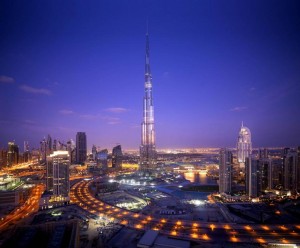By Roger K. Lewis www.washingtonpost.com
On Jan. 4, the new decade’s first day of business, grand openings of two extraordinary real estate projects were widely reported: the $8.5 billion, 18.5 million square-foot City Center complex in Las Vegas; and the $1.5 billion Burj Khalifa in Dubai, the world’s tallest skyscraper, standing more than a half-mile high on the east coast of the Arabian peninsula. Media commentators noted that both celebrations seemed like punctuation marks signaling the end of a decade of real estate investment excess and architectural extravagance.

You don’t have to be a fortune teller to predict that huge, costly luxury projects such as City Center and the Burj Khalifa (formerly the Burj Dubai) will be emulated infrequently during the second decade of the 21st century.
As if to underscore the irony of this pair of grand openings, reports accompanying the coverage talked about diminished project opportunities and job losses afflicting architecture firms, including the firms that designed City Center and the Burj. Other Jan. 4 news stories continued coverage of the enduring global economic recession, weak real estate market and credit constraints, all of which affect architectural prospects.
What will keep architects busy during this decade? And will people be as interested when less exuberant, less idiosyncratic projects are completed and opened, given the propensity of the media and the public to focus on the exuberant and the idiosyncratic?
Part of the answer springs from the quest for sustainability and projects with ever-smaller carbon footprints, the goal being to conserve energy and curtail global climate change. Architects are especially committed to achieving sustainability through design. And, fortunately, more of their clients — property owners, government agencies, cultural institutions — share that commitment.
Sustainability is becoming an indispensable building attribute embraced by real estate developers, many of whom now perceive that being green is a necessary marketing asset. Whether selling to buyers or renting to tenants, they think that offering sustainable architecture provides a competitive advantage in the marketplace.
Meanwhile, state, county and municipal authorities, along with the federal government, are adopting policies, regulations and design standards encouraging, if not mandating, green architecture. To conserve resources and energy, the U.S. General Services Administration now has specific sustainability requirements for all new federal building projects.
In this decade, a much higher percentage of development and redevelopment projects will receive a LEED rating of silver, gold or platinum. LEED (Leadership in Energy and Environmental Design) is a sustainability measurement protocol developed and administered by the U.S. Green Building Council. Thousands of American architects and engineers have earned LEED certificates from the council.
A LEED rating takes into account a broad spectrum of building attributes, among them the types and amounts of energy consumed for both construction and operation. That includes heating and cooling, ventilation, lighting, and equipment; the use of green, energy-saving materials that are recycled, replenishable, locally produced and environmentally safe; the effectiveness of building geometry and detailing in reducing energy needs; and efficiency in managing water and waste.
LEED evaluation also rewards low-impact site attributes, such as soils that favor construction, a lack of disturbed wetlands, the protection and use of native vegetation, the availability of infrastructure and public transportation, and pedestrian access to nearby shopping and other community facilities.
Yet by far the greenest real estate development strategy is to avoid designing and constructing a new building.
Despite current use and physical condition, an existing building embodies an enormous amount of previously invested energy and economic resources. That energy and those resources went into producing, transporting, finishing and installing the building’s many materials, as well as acquiring and preparing the building site, including off-site infrastructure.
Many aging, functionally and technologically obsolete buildings may be beyond saving. But many will be worth preserving, not only as the best way to create green architecture, but also to recognize architectural and historic merit.
Thus, instead of designing new, monumentally sized edifices with equally monumental budgets, architects are likely to be kept busy modifying, expanding and repurposing much of America’s existing building stock.
Indeed, transformation of existing buildings probably will account for a growing share of construction in coming years, if not decades. And transforming an existing building frequently can be an opportunity for artful creativity and invention, as aesthetically stimulating as constructing something totally new, grandiose and unconventional.
But will media and public interest in an innovative real estate retrofit match their interest in a multibillion-dollar, architectural tour-de-force? That remains to be seen.
Roger K. Lewis is a practicing architect and a professor emeritus of architecture at the University of Maryland.













